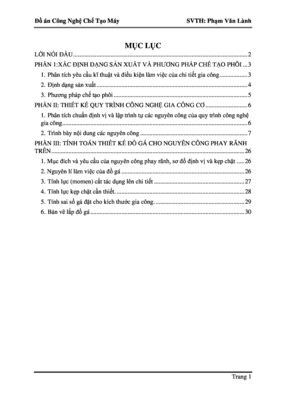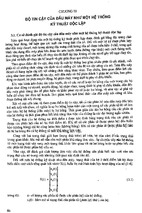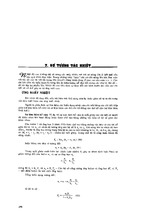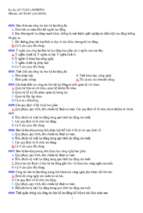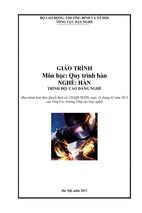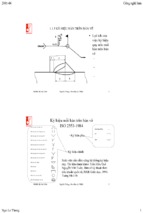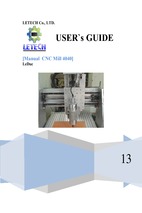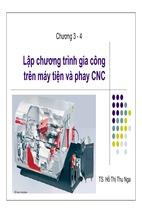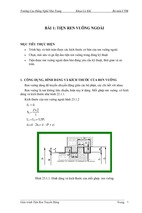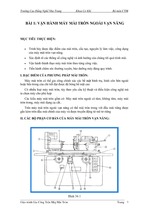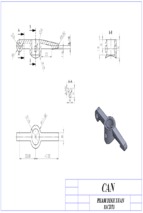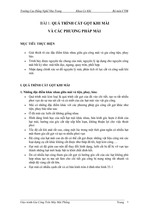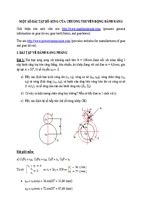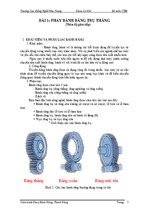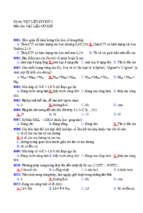Technician Handbook
874 Engine Control Systems II
O2 and A/F Sensor
Diagnosis
OBD II vehicles require two exhaust sensors: one before and one
after the catalytic converter.
The A/F or O2 sensor before the catalytic converter is used by the
ECM to adjust the air/fuel ratio and is in the S1 position (AFS B1 S1).
The O2 sensor after the catalytic converter is used for catalytic
converter efficiency control and monitoring; and is in the S2 position
(O2S B1 S2).
There are several types of oxygen sensors. The two most common
are listed below:
• Narrow range oxygen sensor, typically called an oxygen
(O2) sensor
• Wide range oxygen sensor, typically called an air/fuel ratio
(A/F) sensor
Technical Training
61
Technician Handbook
874 Engine Control Systems II
Oxygen Sensor
Construction and
Operation
The oxygen sensor, sometimes referred to as heated oxygen
sensor, HO2S or O2S, has been in service the longest. It is made of
zirconia (zirconium dioxide), platinum electrodes, and a heater.
There are two types in use: the Cup type and the Planar type. They
vary slightly in construction and operation, but cannot be
interchanged. Refer to the Repair Manual for specifics.
The oxygen sensor generates a voltage signal based on the
amount of oxygen in the exhaust compared to the atmospheric
oxygen.
• When exhaust oxygen content is high (lean), oxygen sensor
voltage output is low.
• When exhaust oxygen content is low (rich), oxygen sensor
voltage output is high.
• During normal operation, the voltage signal cycles from 100
mV to 900 mV (0.1 V to 0.9 V).
The zirconia element has one side exposed to the exhaust stream
while the other side is open to the atmosphere. Each side has a
platinum electrode attached to the zirconium dioxide element. The
platinum electrodes conduct the voltage generated. Contamination
or corrosion of the platinum electrodes or zirconia elements will
reduce the voltage signal output.
Oxygen sensors signal circuits can be tested with a DVOM. Refer to
the Repair Manual for the correct diagnostic procedure.
NOTE
62
Oxygen sensors from different vehicles are NOT interchangeable.
Verify correct part numbers, tag colors, electrical connector colors
and shapes, etc. before installing new parts.
Technical Training
Technician Handbook
874 Engine Control Systems II
Oxygen Sensor Heater
The oxygen sensor cannot produce an accurate voltage signal until
it reaches a minimum operating temperature of 750 degrees F (400
degrees C). It must reach that temperature quickly and stay at that
temperature for effective operation.
To help the oxygen sensor reach its operating temperature quickly,
the ECM turns on current flow through a heating element inside the
sensor. This element heats up as current passes through it.
The ECM controls the circuit based on engine coolant temperature
and engine load (determined from the MAF sensor signal). The
oxygen sensor heater circuit uses approximately 2 amperes and is
generally turned OFF once the engine reaches normal operating
temperature. Typically, the heater will be turned ON at idle or in
decel fuel cut conditions.
NOTE
Unlike the A/F sensor heater being pulsewidth modulated (PWM),
the O2 sensor heater typically is not.
Typically, when any O2 sensor heater DTCs are present, the ECM
will turn OFF the A/F sensor heater as part of the fail-safe mode.
The fail-safe mode will continue until the ignition switch is turned
OFF.
Because proper operation of the oxygen sensor depends on correct
sensor temperature, the heater should always be checked when
testing the sensor. A DVOM can be used to test the O2 sensor
heater operation. Refer to the Repair Manual for the correct
diagnostic procedure and values.
Technical Training
63
Technician Handbook
874 Engine Control Systems II
NOTE
NOTE
64
Some 2004 and later model vehicles will utilize a relay in the O2
sensor heater circuit. Refer to the Repair Manual and the Electrical
Wiring Diagram for the correct diagnostic procedure, values and
wiring diagram.
With the ignition ON, engine OFF, voltage at the ECM side of the
heater circuit should be battery voltage. With the engine ON, voltage
at the ECM side of the heater circuit should be less than battery
voltage due to the ECM grounding the circuit and the oxygen sensor
heater load. Also, some types of O2 sensor heater circuits (most
Planar) are pulsewidth modulated (PWM). Comparing the O2
sensor heater voltage readings at ignition ON, engine OFF and
engine ON to a similar known good vehicle at the same temperature
can also aid in diagnosis.
Technical Training
Technician Handbook
874 Engine Control Systems II
A/F Sensor
Construction and
Operation
The A/F sensor, sometimes referred to as the AFR sensor or air/fuel
ratio sensor, looks like an oxygen sensor and serves the same
purpose, but it is different in construction and operation. Instead of a
varying voltage output, the A/F sensor changes its current
(amperage) output in relation to the amount of oxygen in the
exhaust stream. A detection circuit in the ECM uses this amperage
to create a voltage signal that varies with the oxygen content of the
exhaust gases.
• At stoichiometry, there is no current flow and the detection
circuit outputs 3.3 volts.
• When exhaust oxygen content is high (lean), a positive current
is produced and the detection circuit outputs a voltage above
3.3V.
• When exhaust oxygen content is low (rich), a negative current
is produced and the detection circuit outputs a voltage below
3.3V.
These sensors detect A/F ratios over a wider range, allowing the
ECM to more accurately control fuel injection and reduce emissions.
Because of its nature, the A/F sensor signal circuit cannot be tested
with a DVOM. Instead, the Techstream data list parameter is used to
read the A/F sensor signal. Refer to the Repair Manual for the
correct diagnostic procedure.
NOTE
Technical Training
A/F sensors from different vehicles are NOT interchangeable. Verify
correct part numbers, tag colors, electrical connector colors and
shapes, etc. before installing new parts.
65
Technician Handbook
874 Engine Control Systems II
Approximately, 0.4 volt differential is continuously applied across
terminals AF + and AF - (AF +: 3.3V, AF -: 2.9V) of the A/F sensor
signal circuit. The zirconia element is connected in series with these
two terminals and generates an electromotive force based on the
air/fuel ratio. The electromotive force or voltage differential
determines the strength and direction of current flow in the circuit.
When Air/Fuel ratio is at stoiciometric, electromotive force is equal
to about .4 volts. AF- (2.9 volts contant) + electromotive force .4
volts = 3.3 volts. This is equal to the voltage supplied by AF+ (3.3
volts constant). If AF- and AF+ equal each other there is no current
flow in the circuit and is interpreted as a balanced Air/ Fuel Ratio or
Stoiciometric.
66
Technical Training
Technician Handbook
874 Engine Control Systems II
When the electromotive force is less than approx. 0.4 V, voltage is
higher at AF+ than at AF-. This causes current to flow from AF+ to
AF- in accordance with the voltage differential.
Technical Training
67
Technician Handbook
874 Engine Control Systems II
If an electromotive force is higher than approx. 0.4 V, voltage is
higher at AF- than at AF+. This causes current to flow from AF- to
AF+ in accordance with the voltage differential.
68
Technical Training
Technician Handbook
874 Engine Control Systems II
A/F Sensor Heater
A/F sensors operate at temperatures even hotter than O2 sensors,
approximately 1200 degrees F (650 degrees C).
The A/F sensor heater serves the same purpose as the O2 sensor
heater, but there are some very important differences. A/F sensors
require a much higher operating temperature than O2 sensors and
must heat up to operating temperature very fast (within seconds) so:
• Some vehicles use an A/F Relay (turned on at the same time
as the EFI Relay). A relay is required because the A/F sensor
heater circuit carries up to 9.9 amperes (versus 2 amperes for
oxygen sensor heater) to produce the additional heat needed
by the A/F sensor. Refer to the Repair Manual for correct A/F
sensor heater operating range values.
• This heater circuit is pulsewidth modulated (PWM). When cold,
the duty ratio is high.
• The heater may be ON under normal driving conditions to
maintain proper A/F sensor operating temperature.
Typically, when any A/F sensor heater DTCs are present, the
ECM will turn OFF the A/F sensor heater as part of the fail-safe
mode. The fail-safe mode will continue until the ignition switch is
turned OFF.
Technical Training
69
Technician Handbook
874 Engine Control Systems II
A/F Sensor Heater
(cont’d)
NOTE
70
Because proper operation of the A/F sensor depends on correct
sensor temperature, the heater should always be checked when
testing the sensor. A DVOM or oscilloscope can be used to test the
A/F sensor heater operation. Refer to the Repair Manual for the
correct diagnostic procedure and values.
With the ignition ON, engine OFF, voltage at the ECM side of the
heater circuit should be battery voltage. With the engine ON, voltage
at the ECM side of the heater circuit should be less than battery
voltage (pulsewidth modulated [PWM]; varies with sensor
temperature) due to the ECM grounding the circuit and the A/F
sensor heater load. Comparing the A/F sensor heater voltage
readings at ignition ON, engine OFF and engine ON to a similar
known good vehicle at the same temperature can also aid in
diagnosis.
Technical Training
Technician Handbook
874 Engine Control Systems II
When O2 sensor voltage is compared to A/F sensor output it is easy
to see the accuracy differences over the entire air fuel ratio range. It
is important to remember that voltage readings for the A/F sensor
are calculated by the ECM and cannot be measured at the sensor.
Technical Training
71
Technician Handbook
874 Engine Control Systems II
72
Technical Training
Technician Handbook
874 Engine Control Systems II
O2 Sensor Monitors
Technical Training
The O2 – A/F sensors, heaters, and catalyst are monitored by three
separate readiness monitors: the O2 Sensor, O2 Sensor Heater and
Catalyst Efficiency monitors. All three monitors require different
readiness monitor drive patterns. Refer to the Repair Manual for the
specific readiness monitor drive patterns and enabling conditions.
73
Technician Handbook
874 Engine Control Systems II
O2 Sensor Monitor
Monitor Methods
The O2 Sensor monitor checks for A/F and O2 sensor circuit
malfunctions, slow response rate, no activity, and/or high or low
voltage. This monitor also checks for the sensor signal stuck lean
or rich.
The O2 Sensor monitor changed from a passive to an active system
with some 2003 and later models.
• Prior to 2003, and some 2003 models: The O2 Sensor
monitor checks for sensor circuit malfunctions, for slow
response rate, and for a malfunction of the sensor’s heater
circuit. Each condition sets a DTC. If the ECM detects varying
fuel injection volumes, it takes advantage of the condition to
measure signal response (fast sensor response indicates a
good sensor).
• Some 2003 and most later models: The Active Air/Fuel Ratio
Control monitor forces the air/fuel ratio lean and rich to check
for deterioration in catalytic converter performance as well as
A/F sensor and/or O2 sensor malfunctions. In addition to active
testing, the ECM monitors sensor output during certain engine
operating conditions (such as closed throttle deceleration) and
can set DTCs based on abnormal sensor readings.
74
Technical Training
Technician Handbook
874 Engine Control Systems II
A/F and O2 Sensor DTCs
• O2 (A/F) Sensor Circuit Faults: Low Voltage, High
Voltage, Malfunction
• O2 (A/F) Sensor Signal Faults: Stuck Rich, Stuck Lean,
Slow Response, No Activity
• O2 (A/F) Sensor Pumping Current Circuit Faults: Open,
Low/High
• O2 (A/F) Sensor Reference Ground Circuit: Low/High
O2 Sensor Heater
Monitor
Heater DTCs
The O2 Sensor Heater monitor checks for A/F and O2 sensor heater
circuit malfunctions, and high or low voltage.
• Heater Control Circuit: High, Low, and Malfunction
• Circuit Faults: Low Voltage, High Voltage, Malfunction
NOTE
Technical Training
Depending on vehicle year, make, and model, the O2 Sensor and
O2 Sensor Heater monitors may not check for all of the
malfunctions listed in the illustration. Refer to the Repair Manual for
specific DTC information.
75
Technician Handbook
874 Engine Control Systems II
Catalytic Converter
Overview
Catalytic converter failures generally fall in the category of physical
damage or catalyst failure. Physical damage usually can be visually
identified – cracks, dents, etc. Internally, the structure can be cracked,
broken, or melted. Where high heat may lead to catalyst failure, the
engine and related systems need to be thoroughly checked.
Catalyst performance before OBD II was determined differently in
many states by test equipment. OBD II systems can determine
catalyst performance. Performance deteriorates in many cases when
the catalyst becomes coated with foreign materials. Contaminated
fuel, sealants, or coolant can all affect catalyst performance.
The sub (S2) O2 sensor is used to adjust the oxygen level in the
catalytic converter to achieve the best catalytic converter efficiency
possible. As a catalytic converter deteriorates, its ability to store
oxygen is also reduced. During conversion, the stored oxygen is
rapidly depleted. The sub O2 sensor detects this and, within a very
limited range, the ECM will reduce the amount of fuel injected,
providing more oxygen to the converter. Oxygen levels build up,
driving the O2 signal downward. At a predetermined point, fuel control
will return to stoichiometric A/F ratio. When this happens, oxygen
again will be depleted, driving the sub O2 signal upward, and the cycle
will repeat itself. The rate at which this cycle repeats depends on how
much the catalyst has deteriorated, engine load, and the amount of
correction as determined by the ECM's fuel control programming.
76
Technical Training
Technician Handbook
874 Engine Control Systems II
Catalytic Converter
Monitor
The diagnostic system measures the oxygen storage capacity (OSC) of
the catalyst. This is based on the correlation between catalyst
conversion efficiency and oxygen storage capacity. Catalyst efficiency
is monitored by comparing the pre-catalyst O2 or A/F sensor output
signal with the signal received from the post-catalyst O2 sensor. The
ECM uses voltage variations between these sensors to measure the
catalyst performance.
When the converter is operating properly, the post-catalyst sensor is
significantly less active than the pre-catalyst sensor. This is because
the converter stores and releases oxygen as needed during its
reduction and oxidation processes, so the post-catalyst sensor is
exposed to exhaust gases with very little variation in oxygen levels.
After the engine and catalyst are warmed up and the readiness monitor
enabling conditions are met, the ECM will run the Catalyst monitor.
Catalyst warm-up is determined by a calculation in the ECM’s internal
programming. Engine load, engine coolant temperature, and time are
the primary factors used to determine catalyst temperature.
Later model vehicles equipped with A/F sensors in the S1 position
utilize Active Air/Fuel Ratio Control to monitor the efficiency of the
catalytic converter, A/F sensor, and O2 sensor. See the Active Air/Fuel
Ratio Control topic in this section for more information.
Catalytic Converter
Efficiency Below
Threshold DTCs
Technical Training
P0420: Catalyst System Efficiency Below Threshold (Bank 1) (two-trip)
P0430: Catalyst System Efficiency Below Threshold (Bank 2) (two-trip)
77
Technician Handbook
874 Engine Control Systems II
There are three distinct Techstream tests that can be used to check
the exhaust sensors and catalyst efficiency. These tests are typically
used for early model vehicles with Passive type monitors. These
tests are not the same for an Active type monitoring system which is
explained at the end of this section.
O2 and A/F Sensor
Activation
Check the O2 Sensor monitor Test Results and Test Details prior to
and after diagnosis and repair to confirm that the repair has been
effective.
Because proper operation of the A/F and O2 sensors depends on
correct sensor temperature, the heater should always be checked
when testing the sensor.
When trying to determine the cause of an A/F or O2 sensor issue,
check the Freeze Frame data and duplicate the conditions. Use the
Technical Information System (TIS) for Repair Manual (RM) and
Electrical Wiring Diagram (EWD) information, and look for
applicable Service Bulletins (SB).
Prior to determining if an A/F or O2 sensor is faulty, it is essential
that the A/F and/or O2 (exhaust) sensors be at operating
temperature. Prior to testing the exhaust sensors, run the engine in
Park between 2,500 and 3,000 RPM for approximately 3 minutes.
This will ensure that all exhaust sensors are at operating
temperature and ready for testing.
78
Technical Training
Technician Handbook
874 Engine Control Systems II
O2 and A/F Sensor
Test 1
For A/F (S1) sensor equipped vehicles:
After activating the sensors with the proper engine racing pattern,
alternate the engine speed between 2,000 and 3,000 RPM in 2second intervals while observing the A/F and O2 sensor parameter
readings with the Techstream. The next image shows a graphed
snapshot of this test.
For O2 (S1) sensor equipped vehicles:
After activating the sensors with the proper engine racing pattern,
run the engine speed at approximately 2,500–3,000 RPM while
observing the O2 sensor parameter readings with the Techstream.
Refer to the Repair Manual for the correct responses and values.
Comparing the responses of the exhaust sensors from one bank to
the other (if applicable) or to the exhaust sensor responses from a
similar known good vehicle can also in diagnosis.
Technical Training
79
Technician Handbook
874 Engine Control Systems II
O2 and A/F Sensor
Activation and Test 1
Snapshot
In the illustration, the engine speed was alternated between 2,000 and
3,000 RPM in 2-second intervals while observing the A/F and/or O2 sensor
parameter readings with the Techstream on a known good vehicle in Park
with the engine at operating temperature. The A/F and O2 sensors and
catalytic converters have passed this test because all sensors fluctuated,
and the O2 (S2) sensors did not fluctuate up and down frequently.
If either voltage output of the A/F or O2 sensor does not fluctuate, or if
there is noise in the waveform of either sensor, this may indicate a
malfunctioning sensor.
If the voltage outputs of both sensors on the same bank, or all sensors on
both banks if applicable, remain lean or rich, the air/fuel ratio may be
extremely lean or rich. If this is the case, perform an A/F Control active test
with the Techstream. See the O2 and A/F Sensor Test 2: Injector Volume or
A/F Control Active Test portion of this section for more information.
On some vehicles, the Catalyst Efficiency Below Threshold DTC (P0420,
P0430) detection conditions may be so small that a malfunction may not be
observable with these tests. Typically, if the MAF sensor, A/F sensor, O2
sensor, and fuel trims are within specifications, and a P0420 or P0430 DTC
continues to set after clearing the DTCs and re-running the monitor, this
may indicate a faulty catalytic converter.
Also, always check the Catalyst Efficiency monitor Test Details after running
the monitor. If a Test Result is close to the Min Limit, this may result in an
intermittent MIL ON condition. If the Test Result is well within the Min and
Max Limits after making a repair attempt, clearing DTCs and re-running the
monitor, this probably means that the repair attempt was successful. See
the Readiness Monitor Test Details portion of the OBD section in this course
for more information.
NOTE
80
If there are engine issues such as misfires, faulty injectors, incorrect timing,
etc., these may cause the catalytic converter to malfunction prematurely.
Ensure that the engine is running correctly and that no misfires, fuel trim, or
other engine issues are present before diagnosing the catalytic converter.
Technical Training
- Xem thêm -


